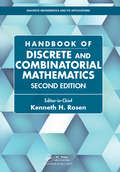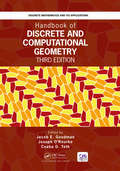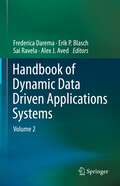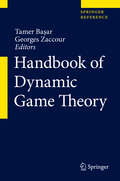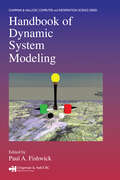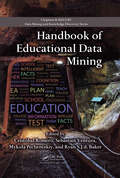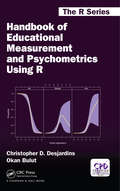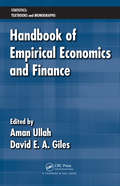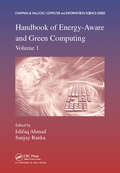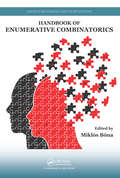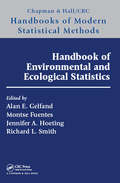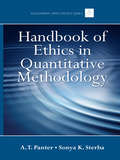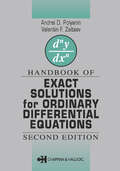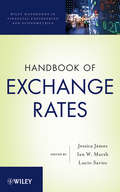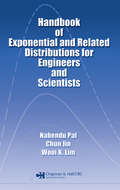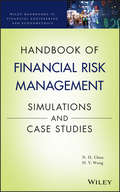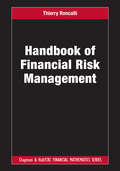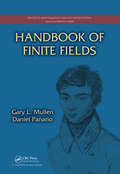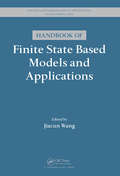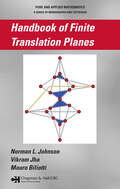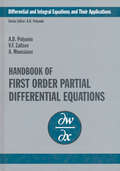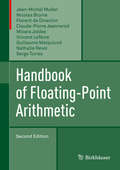- Table View
- List View
Handbook of Discrete and Combinatorial Mathematics (Discrete Mathematics and Its Applications)
by Kenneth H. RosenHandbook of Discrete and Combinatorial Mathematics provides a comprehensive reference volume for mathematicians, computer scientists, engineers, as well as students and reference librarians. The material is presented so that key information can be located and used quickly and easily. Each chapter includes a glossary. Individual topics are covered in sections and subsections within chapters, each of which is organized into clearly identifiable parts: definitions, facts, and examples. Examples are provided to illustrate some of the key definitions, facts, and algorithms. Some curious and entertaining facts and puzzles are also included. Readers will also find an extensive collection of biographies. This second edition is a major revision. It includes extensive additions and updates. Since the first edition appeared in 1999, many new discoveries have been made and new areas have grown in importance, which are covered in this edition.
Handbook of Discrete and Computational Geometry (Discrete Mathematics and Its Applications)
by Jacob E. Goodman Csaba D. Tóth Joseph O’RourkeThe Handbook of Discrete and Computational Geometry is intended as a reference book fully accessible to nonspecialists as well as specialists, covering all major aspects of both fields.The book offers the most important results and methods in discrete and computational geometry to those who use them in their work, both in the academic world—as researchers in mathematics and computer science—and in the professional world—as practitioners in fields as diverse as operations research, molecular biology and robotics.Discrete geometry has contributed significantly to the growth of discrete mathematics in recent years. This has been fueled partly by the advent of powerful computers and by the recent explosion of activity in the relatively young field of computational geometry. This synthesis between discrete and computational geometry lies at the heart of this Handbook.A growing list of application fields includes combinatorial optimization, computer-aided design, computer graphics, crystallography, data analysis, error-correcting codes, geographic information systems, motion planning, operations research, pattern recognition, robotics, solid modeling, and tomography.
Handbook of Dynamic Data Driven Applications Systems: Volume 2
by Sai Ravela Frederica Darema Erik P. Blasch Alex J. AvedThis Second Volume in the series Handbook of Dynamic Data Driven Applications Systems (DDDAS) expands the scope of the methods and the application areas presented in the first Volume and aims to provide additional and extended content of the increasing set of science and engineering advances for new capabilities enabled through DDDAS. The methods and examples of breakthroughs presented in the book series capture the DDDAS paradigm and its scientific and technological impact and benefits. The DDDAS paradigm and the ensuing DDDAS-based frameworks for systems’ analysis and design have been shown to engender new and advanced capabilities for understanding, analysis, and management of engineered, natural, and societal systems (“applications systems”), and for the commensurate wide set of scientific and engineering fields and applications, as well as foundational areas. The DDDAS book series aims to be a reference source of many of the important research and development efforts conducted under the rubric of DDDAS, and to also inspire the broader communities of researchers and developers about the potential in their respective areas of interest, of the application and the exploitation of the DDDAS paradigm and the ensuing frameworks, through the examples and case studies presented, either within their own field or other fields of study. As in the first volume, the chapters in this book reflect research work conducted over the years starting in the 1990’s to the present. Here, the theory and application content are considered for:Foundational MethodsMaterials SystemsStructural SystemsEnergy SystemsEnvironmental Systems: Domain Assessment & Adverse Conditions/WildfiresSurveillance SystemsSpace Awareness SystemsHealthcare SystemsDecision Support SystemsCyber Security SystemsDesign of Computer Systems The readers of this book series will benefit from DDDAS theory advances such as object estimation, information fusion, and sensor management. The increased interest in Artificial Intelligence (AI), Machine Learning and Neural Networks (NN) provides opportunities for DDDAS-based methods to show the key role DDDAS plays in enabling AI capabilities; address challenges that ML-alone does not, and also show how ML in combination with DDDAS-based methods can deliver the advanced capabilities sought; likewise, infusion of DDDAS-like approaches in NN-methods strengthens such methods. Moreover, the “DDDAS-based Digital Twin” or “Dynamic Digital Twin”, goes beyond the traditional DT notion where the model and the physical system are viewed side-by-side in a static way, to a paradigm where the model dynamically interacts with the physical system through its instrumentation, (per the DDDAS feed-back control loop between model and instrumentation).
Handbook of Dynamic Game Theory
by Georges Zaccour Tamer BaşarThis will be a two-part handbook on Dynamic Game Theory and part of the Springer Reference program. Part I will be on the fundamentals and theory of dynamic games. It will serve as a quick reference and a source of detailed exposure to topics in dynamic games for a broad community of researchers, educators, practitioners, and students. Each topic will be covered in 2-3 chapters with one introducing basic theory and the other one or two covering recent advances and/or special topics. Part II will be on applications in fields such as economics, management science, engineering, biology, and the social sciences.
Handbook of Dynamic System Modeling
by Paul A. FishwickThe topic of dynamic models tends to be splintered across various disciplines, making it difficult to uniformly study the subject. Moreover, the models have a variety of representations, from traditional mathematical notations to diagrammatic and immersive depictions. Collecting all of these expressions of dynamic models, the Handbook of Dynamic Sy
Handbook of Educational Data Mining (Chapman & Hall/CRC Data Mining and Knowledge Discovery Series)
by Mykola Pechenizkiy Sebastian Ventura Cristóbal Romero Ryan S.J.d. BakerHandbook of Educational Data Mining (EDM) provides a thorough overview of the current state of knowledge in this area. The first part of the book includes nine surveys and tutorials on the principal data mining techniques that have been applied in education. The second part presents a set of 25 case studies that give a rich overview of the problems
Handbook of Educational Measurement and Psychometrics Using R (Chapman & Hall/CRC The R Series)
by Christopher D. Desjardins Okan BulutCurrently there are many introductory textbooks on educational measurement and psychometrics as well as R. However, there is no single book that covers important topics in measurement and psychometrics as well as their applications in R. The Handbook of Educational Measurement and Psychometrics Using R covers a variety of topics, including classical test theory; generalizability theory; the factor analytic approach in measurement; unidimensional, multidimensional, and explanatory item response modeling; test equating; visualizing measurement models; measurement invariance; and differential item functioning.This handbook is intended for undergraduate and graduate students, researchers, and practitioners as a complementary book to a theory-based introductory or advanced textbook in measurement. Practitioners and researchers who are familiar with the measurement models but need to refresh their memory and learn how to apply the measurement models in R, would find this handbook quite fulfilling. Students taking a course on measurement and psychometrics will find this handbook helpful in applying the methods they are learning in class. In addition, instructors teaching educational measurement and psychometrics will find our handbook as a useful supplement for their course.
Handbook of Empirical Economics and Finance (Statistics: A Series of Textbooks and Monographs)
by Aman Ullah David E. A. GilesHandbook of Empirical Economics and Finance explores the latest developments in the analysis and modeling of economic and financial data. Well-recognized econometric experts discuss the rapidly growing research in economics and finance and offer insight on the future direction of these fields.Focusing on micro models, the first group of chapters de
Handbook of Energy-Aware and Green Computing, Volume 1 (Chapman & Hall/CRC Computer and Information Science Series)
by Sanjay Ranka Ishfaq AhmadImplementing energy-efficient CPUs and peripherals as well as reducing resource consumption have become emerging trends in computing. As computers increase in speed and power, their energy issues become more and more prevalent. The need to develop and promote environmentally friendly computer technologies and systems has also come to the forefront
Handbook of Enumerative Combinatorics (Discrete Mathematics and Its Applications)
by Miklós BónaPresenting the state of the art, the Handbook of Enumerative Combinatorics brings together the work of today's most prominent researchers. The contributors survey the methods of combinatorial enumeration along with the most frequent applications of these methods.This important new work is edited by Miklos Bona of the University of Florida where he
Handbook of Environmental and Ecological Statistics (ISSN)
by Alan Gelfand; Montse Fuentes; Jennifer A. Hoeting; Richard L. SmithThis handbook focuses on the enormous literature applying statistical methodology and modelling to environmental and ecological processes. The 21st century statistics community has become increasingly interdisciplinary, bringing a large collection of modern tools to all areas of application in environmental processes. In addition, the environmental community has substantially increased its scope of data collection including observational data, satellite-derived data, and computer model output. The resultant impact in this latter community has been substantial; no longer are simple regression and analysis of variance methods adequate. The contribution of this handbook is to assemble a state-of-the-art view of this interface. Features: An internationally regarded editorial team. A distinguished collection of contributors. A thoroughly contemporary treatment of a substantial interdisciplinary interface. Written to engage both statisticians as well as quantitative environmental researchers. 34 chapters covering methodology, ecological processes, environmental exposure, and statistical methods in climate science.
Handbook of Ethics in Quantitative Methodology (Multivariate Applications Series)
by A. T. Panter Sonya K. SterbaThis comprehensive Handbook is the first to provide a practical, interdisciplinary review of ethical issues as they relate to quantitative methodology including how to present evidence for reliability and validity, what comprises an adequate tested population, and what constitutes scientific knowledge for eliminating biases. The book uses an ethical framework that emphasizes the human cost of quantitative decision making to help researchers understand the specific implications of their choices. The order of the Handbook chapters parallels the chronology of the research process: determining the research design and data collection; data analysis; and communicating findings. Each chapter: Explores the ethics of a particular topic Identifies prevailing methodological issues Reviews strategies and approaches for handling such issues and their ethical implications Provides one or more case examples Outlines plausible approaches to the issue including best-practice solutions. Part 1 presents ethical frameworks that cross-cut design, analysis, and modeling in the behavioral sciences. Part 2 focuses on ideas for disseminating ethical training in statistics courses. Part 3 considers the ethical aspects of selecting measurement instruments and sample size planning and explores issues related to high stakes testing, the defensibility of experimental vs. quasi-experimental research designs, and ethics in program evaluation. Decision points that shape a researchers’ approach to data analysis are examined in Part 4 – when and why analysts need to account for how the sample was selected, how to evaluate tradeoffs of hypothesis-testing vs. estimation, and how to handle missing data. Ethical issues that arise when using techniques such as factor analysis or multilevel modeling and when making causal inferences are also explored. The book concludes with ethical aspects of reporting meta-analyses, of cross-disciplinary statistical reform, and of the publication process. This Handbook appeals to researchers and practitioners in psychology, human development, family studies, health, education, sociology, social work, political science, and business/marketing. This book is also a valuable supplement for quantitative methods courses required of all graduate students in these fields.
Handbook of Exact Solutions for Ordinary Differential Equations
by Andrei D. Polyanin Valentin F. ZaitsevExact solutions of differential equations continue to play an important role in the understanding of many phenomena and processes throughout the natural sciences in that they can verify the correctness of or estimate errors in solutions reached by numerical, asymptotic, and approximate analytical methods. The new edition of this bestselling handboo
Handbook of Exact Solutions to Mathematical Equations (ISSN)
by Andrei D. PolyaninThis reference book describes the exact solutions of the following types of mathematical equations:● Algebraic and Transcendental Equations ● Ordinary Differential Equations ● Systems of Ordinary Differential Equations ● First-Order Partial Differential Equations ● Linear Equations and Problems of Mathematical Physics ● Nonlinear Equations of Mathematical Physics ● Systems of Partial Differential Equations ● Integral Equations ● Difference and Functional Equations ● Ordinary Functional Differential Equations ● Partial Functional Differential EquationsThe book delves into equations that find practical applications in a wide array of natural and engineering sciences, including the theory of heat and mass transfer, wave theory, hydrodynamics, gas dynamics, combustion theory, elasticity theory, general mechanics, theoretical physics, nonlinear optics, biology, chemical engineering sciences, ecology, and more. Most of these equations are of a reasonably general form and dependent on free parameters or arbitrary functions.The Handbook of Exact Solutions to Mathematical Equations generally has no analogs in world literature and contains a vast amount of new material. The exact solutions given in the book, being rigorous mathematical standards, can be used as test problems to assess the accuracy and verify the adequacy of various numerical and approximate analytical methods for solving mathematical equations, as well as to check and compare the effectiveness of exact analytical methods.
Handbook of Exchange Rates
by Lucio Sarno Ian Marsh Jessica JamesPraise for Handbook of Exchange Rates"This book is remarkable. I expect it to become the anchor reference for people working in the foreign exchange field."--Richard K. Lyons, Dean and Professor of Finance, Haas School of Business, University of California Berkeley"It is quite easily the most wide ranging treaty of expertise on the forex market I have ever come across. I will be keeping a copy close to my fingertips."--Jim O'Neill, Chairman, Goldman Sachs Asset ManagementHow should we evaluate the forecasting power of models? What are appropriate loss functions for major market participants? Is the exchange rate the only means of adjustment? Handbook of Exchange Rates answers these questions and many more, equipping readers with the relevant concepts and policies for working in today's international economic climate.Featuring contributions written by leading specialists from the global financial arena, this handbook provides a collection of original ideas on foreign exchange (FX) rates in four succinct sections:* Overview introduces the history of the FX market and exchange rate regimes, discussing key instruments in the trading environment as well as macro and micro approaches to FX determination.* Exchange Rate Models and Methods focuses on forecasting exchange rates, featuring methodological contributions on the statistical methods for evaluating forecast performance, parity relationships, fair value models, and flow-based models.* FX Markets and Products outlines active currency management, currency hedging, hedge accounting; high frequency and algorithmic trading in FX; and FX strategy-based products.* FX Markets and Policy explores the current policies in place in global markets and presents a framework for analyzing financial crises.Throughout the book, topics are explored in-depth alongside their founding principles. Each chapter uses real-world examples from the financial industry and concludes with a summary that outlines key points and concepts.Handbook of Exchange Rates is an essential reference for fund managers and investors as well as practitioners and researchers working in finance, banking, business, and econometrics. The book also serves as a valuable supplement for courses on economics, business, and international finance at the upper-undergraduate and graduate levels.
Handbook of Exponential and Related Distributions for Engineers and Scientists
by Nabendu Pal Chun Jin Wooi K. LimThe normal distribution is widely known and used by scientists and engineers. However, there are many cases when the normal distribution is not appropriate, due to the data being skewed. Rather than leaving you to search through journal articles, advanced theoretical monographs, or introductory texts for alternative distributions, the Handbook of E
Handbook of Financial Cryptography and Security (Chapman & Hall/CRC Cryptography and Network Security Series)
by Burton RosenbergThe Handbook of Financial Cryptography and Security elucidates the theory and techniques of cryptography and illustrates how to establish and maintain security under the framework of financial cryptography. It applies various cryptographic techniques to auctions, electronic voting, micropayment systems, digital rights, financial portfolios, routing
Handbook of Financial Risk Management
by Ngai Hang Chan Hoi Ying WongAn authoritative handbook on risk management techniques and simulations as applied to financial engineering topics, theories, and statistical methodologies The Handbook of Financial Risk Management: Simulations and Case Studies illustrates the practical implementation of simulation techniques in the banking and financial industries through the use of real-world applications. Striking a balance between theory and practice, the Handbook of Financial Risk Management: Simulations and Case Studies demonstrates how simulation algorithms can be used to solve practical problems and showcases how accuracy and efficiency in implementing various simulation methods are indispensable tools in risk management. The book provides the reader with an intuitive understanding of financial risk management and deepens insight into those financial products that cannot be priced traditionally. The Handbook of Financial Risk Management also features:Examples in each chapter derived from consulting projects, current research, and course instructionTopics such as volatility, fixed-income derivatives, LIBOR Market Models, and risk measuresOver twenty-four recognized simulation modelsCommentary, data sets, and computer subroutines available on a chapter-by-chapter basisAs a complete reference for practitioners, the book is useful in the fields of finance, business, applied statistics, econometrics, and engineering. The Handbook of Financial Risk Management is also an excellent text or supplement for graduate and MBA-level students in courses on financial risk management and simulation.
Handbook of Financial Risk Management (Chapman and Hall/CRC Financial Mathematics Series)
by Thierry RoncalliDeveloped over 20 years of teaching academic courses, the Handbook of Financial Risk Management can be divided into two main parts: risk management in the financial sector; and a discussion of the mathematical and statistical tools used in risk management. This comprehensive text offers readers the chance to develop a sound understanding of financial products and the mathematical models that drive them, exploring in detail where the risks are and how to manage them. Key Features: Written by an author with both theoretical and applied experience Ideal resource for students pursuing a master’s degree in finance who want to learn risk management Comprehensive coverage of the key topics in financial risk management Contains 114 exercises, with solutions provided online at www.crcpress.com/9781138501874
Handbook of Finite Fields (Discrete Mathematics and Its Applications)
by Gary L. Mullen Daniel PanarioPoised to become the leading reference in the field, the Handbook of Finite Fields is exclusively devoted to the theory and applications of finite fields. More than 80 international contributors compile state-of-the-art research in this definitive handbook. Edited by two renowned researchers, the book uses a uniform style and format throughout and
Handbook of Finite State Based Models and Applications (Discrete Mathematics and Its Applications)
by Jiacun WangApplicable to any problem that requires a finite number of solutions, finite state-based models (also called finite state machines or finite state automata) have found wide use in various areas of computer science and engineering. Handbook of Finite State Based Models and Applications provides a complete collection of introductory materials on fini
Handbook of Finite Translation Planes (Chapman & Hall/CRC Pure and Applied Mathematics)
by Norman Johnson Vikram Jha Mauro BiliottiThe Handbook of Finite Translation Planes provides a comprehensive listing of all translation planes derived from a fundamental construction technique, an explanation of the classes of translation planes using both descriptions and construction methods, and thorough sketches of the major relevant theorems.From the methods of Andre to coordi
Handbook of First-Order Partial Differential Equations (Differential and Integral Equations and Their Applications)
by Andrei D. Polyanin Valentin F. Zaitsev Alain MoussiauxThis book contains about 3000 first-order partial differential equations with solutions. New exact solutions to linear and nonlinear equations are included. The text pays special attention to equations of the general form, showing their dependence upon arbitrary functions. Each section outlines basic solution methods for the differential equations in that section. The text presents equations and their applications in areas such as differential geometry, nonlinear mechanics, gas dynamics, heat and mass transfer, and wave theory. This handbook is essential for researchers, engineers and students of applied mathematics, mechanics, control theory, and the engineering sciences.
Handbook of Floating-Point Arithmetic
by Jean-Michel Muller Nicolas Brunie Florent De Dinechin Claude-Pierre Jeannerod Mioara Joldes Vincent Lefèvre Guillaume Melquiond Nathalie Revol Serge TorresFloating-point arithmetic is the most widely used way of implementing real-number arithmetic on modern computers. However, making such an arithmetic reliable and portable, yet fast, is a very difficult task. As a result, floating-point arithmetic is far from being exploited to its full potential. This handbook aims to provide a complete overview of modern floating-point arithmetic. So that the techniques presented can be put directly into practice in actual coding or design, they are illustrated, whenever possible, by a corresponding program. The handbook is designed for programmers of numerical applications, compiler designers, programmers of floating-point algorithms, designers of arithmetic operators, and more generally, students and researchers in numerical analysis who wish to better understand a tool used in their daily work and research.
Handbook of Forensic Statistics (ISSN)
by David Banks, Karen Kafadar, David H. Kaye and Maria TackettHandbook of Forensic Statistics is a collection of chapters by leading authorities in forensic statistics. Written for statisticians, scientists, and legal professionals having a broad range of statistical expertise, it summarizes and compares basic methods of statistical inference (frequentist, likelihoodist, and Bayesian) for trace and other evidence that links individuals to crimes, the modern history and key controversies in the field, and the psychological and legal aspects of such scientific evidence.Specific topics include uncertainty in measurements and conclusions; statistically valid statements of weight of evidence or source conclusions; admissibility and presentation of statistical findings; and the state of the art of methods (including problems and pitfalls) for collecting, analyzing, and interpreting data in such areas as forensic biology, chemistry, and pattern and impression evidence. The particular types of evidence that are discussed include DNA, latent fingerprints, firearms and toolmarks, glass, handwriting, shoeprints, and voice exemplars.
